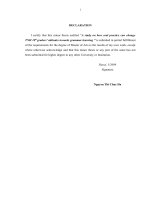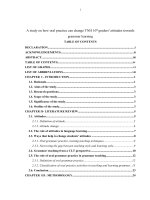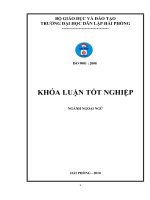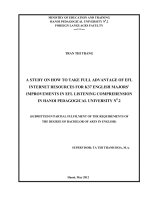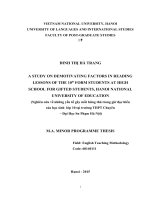A study on how scriptwriters flout certain maxims of Grice's cooperative principle to create verbal irony through the sitcom Friends from episode 1 to 10
Bạn đang xem bản rút gọn của tài liệu. Xem và tải ngay bản đầy đủ của tài liệu tại đây (142.81 KB, 7 trang )
A study on how scriptwriters flout certain
maxims of Grice's cooperative principle to
create verbal irony through the sitcom "Friends"
from episode 1 to episode 10
Đào Thị Vân Hồng
Trường Đại học Ngoại Ngữ
Luận văn ThS. Chuyên ngành: English Linguistics; Mã số: 60 22 15
Người hướng dẫn: Assoc. Prof. Dr. Trần Xuân Điệp
Năm bảo vệ: 2010
Keywords:
Content:
PART 1: THE INTRODUCTION
1.1.Rationale
Verbal irony is a common form of speech used in daily discourse. The reason why irony
is deliberately chosen over its literal counterpart is because it serves several functions that cannot
be achieved through a literal utterance. These functions are derived from the very nature of
verbal irony that distinguishes it from a literal statement.
There are many ways to create verbal irony. Different approaches have different ways to
clarify the mechanism in which verbal irony is generated, but none of which has reached their
fulfillment. This study, thus, is carried out in the light of pragmatic approach in which verbal
irony is considered to be the product of the art of flouting certain maxims of Grice‟s cooperative
principle (Grice, 1975). This theory helps to analyze not only the linguistic features of an ironic
utterance but also its functions in comparison with its literal counterpart. This is the first reason
why the author decided to choose Grice‟s cooperative principle the basis for this study.
It is also necessary to provide an explanation for the choice of analyzing the scripts of the
sitcom “Friends”. According to Alison, “although British comedy has a high reputation and used
to claim a higher degree of subtlety and irony, some of the most popular recent sitcoms are from
the USA” (2006: 91). Among all American sitcoms, “Friends” is considered to be one of the
most typical and successful ones. It was even so popular that it was rerun in 1997 as the
beginning of Channel 4‟s night of comedy. The success of the series can be attributable to many
factors, among which, the great potential for verbal irony created by the language used itself
plays an important part. The verbal irony appeared in the series have not only attracted the young
but also made “Friends” a sitcom for every family.
In analyzing the scripts of the sitcom “Friends” from episode 1 to episode 10, this study
aims to unpack the relationship between the verbal irony and the Cooperative Principle in the
sitcom “Friends”, discover how scriptwriters flout certain maxims to create verbal irony and how
the implied message behind the verbal irony is conveyed.
1.2. Aims of the study
This study is carried out specifically to aim at:
(1) revisiting some theoretical background knowledge of implicatures, (especially
conversational implicatures), Grice‟s cooperative principles and verbal irony.
(2) investigating how verbal irony is generated by the art of flouting certain maxims
of Grice‟s conversational cooperative principles in the scripts of the sitcom “Friends”
from episode 1 to episode 10.
(3) identifying which of the maxims of Grice‟s conversational cooperative principle is
more likely to be flouted to produce verbal irony.
1.3. Research questions
This study is supposed to answer the following questions:
(1) How verbal irony is created by the art of flouting certain maxims of Grice‟s
conversational cooperative principles in the scripts of the sitcom “Friends” from
episode 1 to episode 10?
(2) Which of the maxims of Grice‟s conversational cooperative principle is the most
likely to be flouted to produce verbal irony?
1.4. Significance of the study
1.4.1. In theory
This study is designed to enhance Grice‟s observation on how people use language to
mean much more than the words they actually say. It also tries to prove that in communication,
when interlocutors aim to generate verbal irony, although the maxim of quality is the most likely
to be flouted as stated by Levinson (1984), other maxims are flouted as well. Besides, by
exploring the art of flouting certain maxims of Grice‟s cooperative principles to create irony, the
author means to give evidence that linguistic features do contribute a great deal to the success of
that sitcom.
1.4.2. In practice
It is because language is for communication. In other words, language is used to
realize socio-cultural functions, some of which can be to save face or amuse people. In these
situations, in order to communicate successfully (in both production and reception), people
should be more able to realize these functions. Thus, this paper aims at facilitating
interlocutors to be better-aware of the cases when speakers flout certain maxims with the
intention of generating verbal irony, which helps interlocutors to be more successful in
communication.
1.5. Scope of the study
The research on non-observances of maxims of Grice‟s cooperative principle is so
broad that it is impossible to cover all its aspects. Therefore, this study narrows down the
study only to the art of flouting certain maxims of Grice‟s cooperative principles to create
verbal irony.
Furthermore, the data are only collected from scripts of the American sitcom “Friends” in
the first season (from episode 1 to episode 10) in regard with the limit of time.
Also, this paper will not be able to deal with the cultural differences when analyzing
ironic dialogues because of the limit of time although is also clear that, in many cases, the fact
that people in non-English speaking countries cannot completely understand irony in English is
due to cultural differences.
Besides, in the scope of this study, figures‟ characters and traits which may have some
effect on the style of humor and the change of voices which sometimes plays a important role in
understanding irony will not be discussed. The reason is that thorough studies on these subjects
will be too broad for this research.
1.6. Design of the study
This thesis is divided into three main parts:
Part 1: Introduction This part is aimed at clarifying the rationale, objectives, research
questions, scope and outline of the study.
Part 2: Development This part includes two chapters:
Chapter I: Literature review This chapter is supposed to provide the readers with the
frame of the theory of the study and some basic concepts.
Chapter II: The study This chapter includes the methods employed by the study, data collection
and analysis procedures. It also lays out the findings of the study.
Part 3: Conclusion This part provides the recapitulation of the main ideas of the study, the
limitations of the study and suggestions for further research
REFERENCES
1. Aitchison, J. (2003). Teach yourself Linguistics. London: Hodder and Stroughton
Educational.
2. Alison, R. (2006). The language of humour. London, New York.
3. Austin, J.L. (1975) “How to do things with words”, Oxford, England
4. Allcorn. S(1994). Anger in the workplace. Westport: Quorum Books.
5. Barbe, K. (1995). Irony in Context. Amsterdam/ Philadelphia: John Benjamins Publishing
Company.
6. Calabrese, K. (2000). Interpersonal conflict & sarcasm in the workplace. Genetic, social &
Geneal Psychology Monographs.
7. Christoph, H. (2006). Linguistic Approaches to Irony – An Analysis of British Newspaper
Comments.
8. Dews, S., Kaplan, J. and Winner, E. (1995). Why not say it directly: The social functions of
irony. Discourse Prpcesses.
9. Dews, S. and Winner, E. (1999). Obligatory processing of literal and nonliteral meanings in
verbal irony. Journal of Pragmatics.
10. Gates, G. (1926). An observational study of anger. Journal of Experimental Psychology.
11. Gibbs, & Colston. (2001). Irony in Language and Thought: A Cognitive Science Reader.
New York: Lawrence Erlbaum Associates.
12. Grice, H.P. (1975). „Logic and conversation‟ In Cole, P. & Morgan, J. (eds.) Syntax and
Semantics, Volume 3. New York: Academic Press.
13. Levinson, S.C. (1984). Pragmatics. London: Cambridge University Press.
14. Littmann, D. C. & Mey, J. L. (1991). “The nature of irony: Towards a computational model
of irony”. Journal of Pragmatics.
15. Muecke, D. (1970). Irony. (J. D. Jump, Ed.) Norfolk, Fakenham: Methuen & Co Ltd.
16. Muecke, D. C. (1980). The Compass of Irony. London and New York: Methuen.
17. Roberts, Richard M. and Roger J. Kreuz. "Why Do People Use Figurative Language?"
18. Peter, G. (1995). Doing Pragmatics. New York: Cambridge University Press.
19. Sperber, D. and Wilson, D. (1981). "Irony and the Use-Mention Distinction." Radical
Pragmatics. Ed. Peter Cole. New York: Academic Press.
20. Thomas, J. (1996). Meaning in Interaction: an Introduction to Pragmatics. London and New
York: Longman.
21. Wilson, D. & Sperber, D. (1992). “On verbal irony”. Lingua.
22. Yule, G. (1996). Pragmatics. Oxford: Oxford University Press.
23.
24.
25. Abrams and Hartman. A glossary of literary terms. From
26. Longman Dictionary of Contemporary English. (2003). Gopsons Papers Limited, New Delhi.
27. Oxford Advanced Learner’s Dictionary. 7
th
edition. Oxford University Press.
